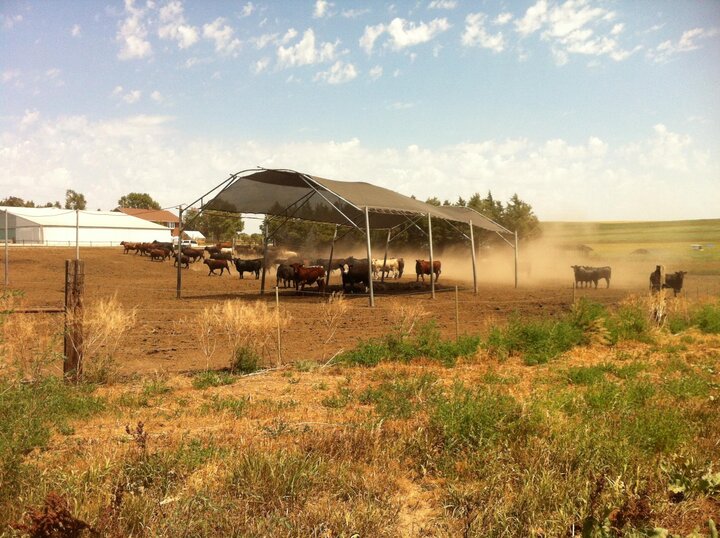Managing Dust in Open Beef Feedlots
Open cattle feedlots combined with hot and drier summer conditions can often times lead to periods of increased dust issues that can become a nuisance. Observations suggest that the worst time for dust to develop is during the late afternoon and at dusk when the temperature begins to drop and wind speed decreases. This is when cattle that have been resting during the hotter part of the day, become more active. This activity creates increased dust that hangs in the cooler evening air.

Strategies to Minimize Dust in Pens
There are a several things that can be done to minimize dust. First, focus efforts on the feedlot pens and then service roads or alleys. In the pens, common strategies would be removal of excess manure, increasing the pen stock density, or application of water.
Pen Maintenance
The most critical strategy to reduce dust is to avoid a buildup of organic matter. Good pen maintenance is important. Pen scraping on a regular basis to remove the manure and excess feed not only limits the amount of dust, but also can help limit moisture buildup on the surface at times when weather is wetter. It is recommended to maintain a 1-2 inch surface layer of well compacted manure and soil.
Stock Density
It has been demonstrated that increasing stock density by concentrating animals in the pen during hot weather is successful in limiting dust. This increases the amount of water in the area distributed by the cattle in the form of manure and urine. There are, however, a few issues that can result with this method. Some of the issues may be:
- inadequate bunk space,
- possible increased disease transmission,
- possible lower gains, and
- if weather conditions change, mud could become an issue.
Under careful management, crowding may be a method worth trying. Each operation must determine the potential benefit against the potential risks involved.
Additives
Application of water to the feedlot surface is the most common and effective method of dust control. This method should begin well in advance of dust becoming a problem. When water is applied to the feedlot surface, maintain a balance between dust control and mud. The application rate should be adjusted to meet the weather conditions, the size of animals and the depth of the manure. Water can be applied with a sprinkler system or mobile units, like water trucks. The surface manure in the lot should be maintained at 25-35 percent water to minimize the dust and also any odors. A higher moisture content can produce odors. Water additions should occur in the evening when the cattle are more active and when the surface is likely to be the driest after the heat of the day.
Producers should be aware that adding water may also increase the relative humidity in the pen and could impair the animal’s ability to lose body heat that they have gained throughout the day. To control fly breeding and odor issues, avoid overwatering vacant pens, fence lines, and feeding areas.
There are also a few chemicals that show potential for dust control, but many have shown little effectiveness in feedlots. All are relatively expensive and require additional applications once pens are cleaned. They may also hinder the value of manure.
Minimizing Dust on Other Parts of the Operation
Controlling dust on the service roads and alleys is best done by sprinkling water and using coarse rock or gravel rather than sand or smaller gravel.
Another effective dust mitigation option is the use of vegetative barriers, such as a windbreak or shelterbelt. They help capture some of the airborne particles and gases, as well as serving as an aesthetic visual screen for the operation.
Management is Key
Management is the key to keeping dust under control. By using some basic dust control techniques, open feedlots can prevent or minimize the problem.
For additional information, a good resource is the Feedlot Dust Control chapter in the Beef Cattle Handbook.
This article was reviewed by Leslie Johnson